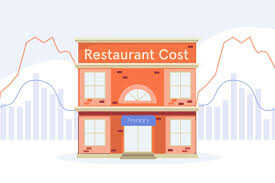Introduction
Being financially literate is an essential component of running a successful restaurant, whether this means having a solid grasp of the unit the economics of owning a restaurant or keeping abreast of the economic trends that could impact your business. While it is obvious that creating works of culinary art is their true passion, they, like most modern chefs, are required to keep an eye on the bottom line. It is a never-ending balancing act to provide customers with a bountiful experience while also keeping a close eye on the costs of food, labour, and a plethora of incidentals, such as the candle wax, courtyard heaters, and site repairs. Providing customers with a bountiful experience is a constant juggling act.

The Economics Of Running A Restaurant
Restaurants, like any other type of business, aim to generate more revenue than is required to cover their initial investment and ongoing operating expenses. It is essential to manage a profitable restaurant that you have a solid understanding of the drivers of both your costs and your revenues.
Why Do Restaurants Struggle So Hard To Make Money!?
To begin, there is no denying that running a small business of any kind is challenging. The urge to put love into your product or service and share it with the world might help you overcome obvious difficulties such as limited access to cash and reduced economies of scale. Therefore, it does not matter what it is that you are selling; independent retail, in particular, is a challenging industry.
In addition, restaurants face a plethora of one-of-a-kind challenges, including managing perishable goods, paying excessive utility bills, and operating the business during odd business hours. If you are interested in learning more about the extraordinary life of a chef, my colleagues and I have been working on a project called The Last Service, which will be released in the spring. In it, we delve into several topics in greater depth.
To put it another way, in contrast to the vast majority of businesses, restaurants not only have to take into account fixed costs and variable labour costs, but they also fail to acknowledge that they are operating with a fixed capacity. Because of this bounded physical restriction, there is a ceiling on how much money they can make.
Restaurant Operating Costs
When calculating operational costs, you must consider the reoccurring costs of running your restaurant. Some examples are listed below: Food stock is bought from various retailers, Payroll, Utilities, Maintenance and Repairs, Inspections, Services like Laundry, Upgrades to Technology, Marketing, and Franchise Fees.
Opening A Franchise
When a company decides to franchise with an established national chain, this can bring instant brand awareness and programmes for training new employees and aid in getting the firm ready for its big launch. According to the estimates provided by the Small Business Administration, the cost of those value-added services is typically included in the franchise fee, ranging from $20,000 to $50,000 per establishment (SBA).
In addition, it is possible that several well-known national chains will require liquid assets greater than one million dollars. Because of this, the typical middle-class entrepreneur may be unable to afford to buy into a franchise.
Buying A Restaurant
The quality of the establishment, its location, and how lucrative the business is all play a role in determining the asking price of a restaurant. The quality of the structure may prevent you from having to spend thousands of dollars on repairs and renovations in the future. Unless you are merely purchasing the restaurant for its equipment and furniture, the location should be perfect for what you have in mind for the establishment. If the restaurant has a better track record of making a profit, the initial investment required to purchase the restaurant should be larger.
Labor And Healthcare
Due to the competitive nature of the labour market, the restaurant business is now experiencing a scarcity of available workers. Some restaurants may be forced to provide their workers with health insurance to comply with the Patient Protection and Affordable Care Act's forthcoming rules, which would increase expenses. Any significant shifts in the labour market, such as a rise in the minimum wage, have the potential to influence the restaurant business.
Food Inflation
The cost of food is going up since the prices of its components are continuing to go up. The restaurant business feels the effects of rising grain, cattle, and poultry prices. Finding economical alternatives to ingredients continues to be a struggle for those looking for them.
Quick-Casual Growth
Within the hospitality business, establishments that combine fast food and informal dining into a single concept are "quick-casual." This growth trend is expected to continue. Many restaurants want to concentrate their marketing efforts on a certain submarket, giving them more pricing flexibility.
Increasing prices: not only are earnings increasing, but also prices. Some business owners of restaurants just boost their pricing across the board. When it comes to my members, they already have the systems and reporting in place that supplies them with the data they require to make adjustments to their prices. They are equipped with recipe pricing cards, are familiar with their menu mix, and are aware of how to increase their prices surgically. They can increase the pricing of their most popular products without raising prices across the board because they are certain that doing so will be sufficient to trigger a shift in overall sales.
They have budgets, and they have modified them to determine where they can cut their food prices to counteract all of this, to find the extra money for labour, or to make it more efficient when it comes to labour. They have made the required adjustments to their budget, which serves as their roadmap for achieving success.

Conclusion
If you are in the restaurant business, having a solid grasp of restaurant economics could mean the difference between your establishment thriving and going out of business over the next five years. The bottom line is that without adequate financial planning, sixty percent of restaurants fail within the first year, and eighty percent fail within the first five years. Restaurants can have vastly different costs depending on their size, geographic location, and overall quality. The restaurant business is experiencing economic consequences due to rising food costs and labour expenditures.









